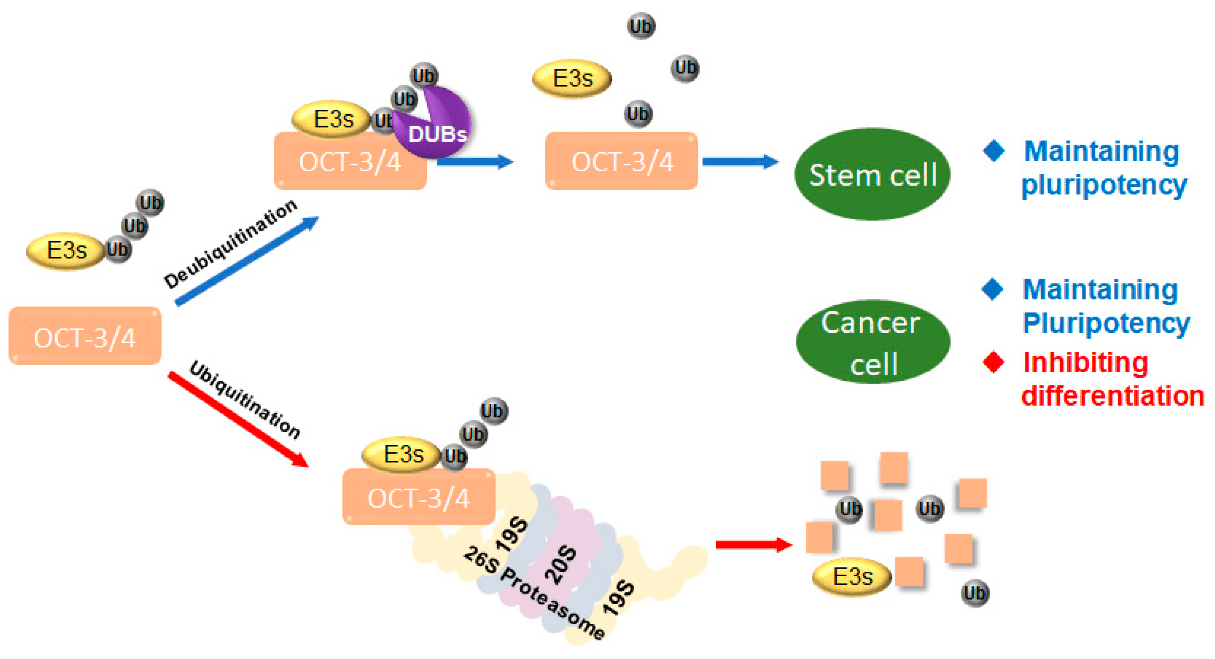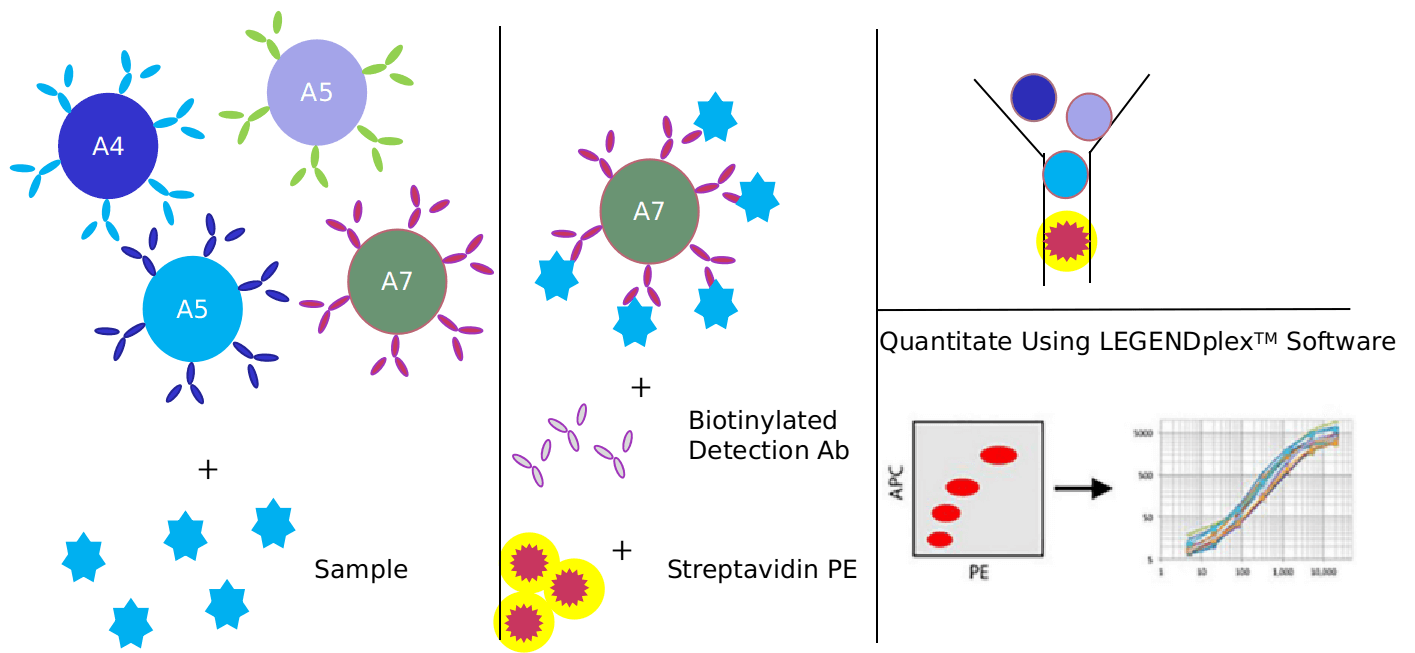Introduction to OCT3/4 signaling pathway
Based on Luminex technology platform, Creative Proteomics provides analysis services for key targets of OCT3/4 signaling pathway.
 OCT3/4 is the full name of POU class 5 homeobox 1 (POU5F1) in the human genome. It is highly conserved in other species. It is an important transcription factor for embryonic stem cells and primordial germ cells to maintain the multi-directional differentiation potential. It is mainly expressed in embryonic stem cells and primordial reproduction. Therefore, its abnormal expression usually indicates germ cell tumorous lesions, and it can also be used in cell biology as one of the stemness identification markers of cancer stem cells.
OCT3/4 is the full name of POU class 5 homeobox 1 (POU5F1) in the human genome. It is highly conserved in other species. It is an important transcription factor for embryonic stem cells and primordial germ cells to maintain the multi-directional differentiation potential. It is mainly expressed in embryonic stem cells and primordial reproduction. Therefore, its abnormal expression usually indicates germ cell tumorous lesions, and it can also be used in cell biology as one of the stemness identification markers of cancer stem cells.
Oct3/4 is regarded as one of the key regulators of pluripotency. Oct-4 is a homeodomain transcription factor of the POU family. This protein is critically involved in the self-renewal of undifferentiated embryonic stem cells. it is frequently used as a marker for undifferentiated cells. Oct-4 expression must be closely regulated; too much or too little will cause differentiation of the cells.
Oct-3/4 is a POU transcription factor that is expressed in embryonic stem (ES) cells and germ cells, and its expression is required to sustain cell self-renewal and pluripotency. Oct-3/4 is the most recognized marker for totipotent ES cells.
OCT3/4 is an important transcription factor for embryonic stem cells and primordial germ cells to maintain multi-directional differentiation potential. In terms of gynecological pathology, OCT3/4 is mainly expressed in dysgerminoma of germ cell tumors of the female reproductive tract, and can also be expressed in a small number of Yolk sac tumor and very few immature teratomas.
Our detectable targets:
| ATG13 | ATG2 | ATG12 | ATG5 | ATG7 | ATG10 |
| ATG3 | ATG4 | JNK | MYD88 | Rac1 | TLR4 |
| LC3I | WIPi2 | ATG16 | PROLC3 | ULK | FIP200 |
| VPS15 | VPS34 | UYRAG | NFκB | RIG-1 | TRAF3 |
| GAS | IRF9 | AMBRA1 | p38 | RIP1 | TRAF5 |
| Histone-H3 | IRF5 | MEK3 | p38MAPK | SH2 | TRAF6 |
| IKK-α | IRS1 | MEK6 | p50 | SLP76 | TRAM |
| TLR3 | IRS2 | MSK1 | p65 | Tak1 | TRIF |
| IPS-1 | ISGF3 | MSK2 | PI3K | TBK1 | Vav |
| IRAK1 | ISRE | mTOR | PKR |
Technology platform:
We provide Luminex technology for OCT3/4 signaling pathway analysis.
Luminex technology is a multifunctional liquid phase analysis platform developed on the basis of colored microspheres, laser technology, applied fluidics and high-speed digital signal processing technology. The core is to encode polypropylene microspheres or magnetic microspheres with fluorescent dyes. By adjusting the different ratios of the two fluorescent dyes, up to 100 microspheres with different fluorescence spectra can be obtained. Antigen-antibody, enzyme-substrate, ligand-receptor binding reactions and nucleic acid hybridization reactions are performed on microspheres with different fluorescence encoding. Qualitative and quantitative analysis by laser detection of microsphere coding and reporter fluorescence separately.
OCT3/4, as an important transcription factor for embryonic stem cells and primordial germ cells to maintain multi-directional differentiation potential, OCT3/4 signaling pathway is widely used in gynecological pathology and cell biology in medical research.
In addition to Luminex Multiplex Assay, Enzyme-linked immunosorbent assay (ELISA), Flow cytometry (FACS analysis) technology can also be provided to meet other customer needs.
Advantages of OCT3/4 signaling pathway detection:
- High sensitivity: The surface area of the microspheres is large, and 100,000 probes can be fixed on each microsphere, which ensures the maximum binding with the target molecules in the sample and improves the detection sensitivity. The lowest detection concentration can reach 0.1pg/mL.
- Strong specificity: Can read the fluorescent signal on a single microsphere, and automatically distinguish between bound and unbound microspheres.
- High accuracy: Without washing, the fluorescence intensity of the reporter molecule on the microsphere is proportional to the bound molecule to be detected. Because the detection range of the Luminex detection platform is large, it does not need to be diluted like ELISA detection, which further reduces errors.

Application of our service:
- To study the regulation mechanism of OCT3/4 signal pathway in disease
- To study the effect of each virus on OCT3/4 signaling pathway
- To study the effects of drugs or therapies on OCT3/4 signaling pathways
Creative Proteomics has developed a signal pathway target detection platform. We are not limited to providing OCT3/4 signal path detection services, but can also provide other signal path detection services. If you want to detect other targets, please contact us and we will customize the service for you. Look forward to working with you.
Reference:
- Zeng F , Chen H , et al. Regulating glioma stem cells by hypoxia through the Notch1 and Oct3/4 signaling pathway. Oncology letters, 2018, 16.



